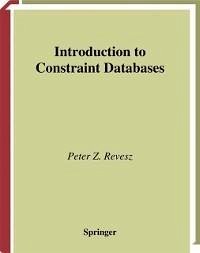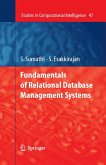Differing from other books on the subject, this one uses the framework of constraint databases to provide a natural and powerful generalization of relational databases. An important theme running through the text is showing how relational databases can smoothly develop into constraint databases, without sacrificing any of the benefits of relational databases whilst gaining new advantages. Peter Revesz begins by discussing data models and how queries may be addressed to them. From here, he develops the theory of relational and constraint databases, including Datalog and the relational calculus, concluding with three sample constraint database systems -- DISCO, DINGO, and RATHER. Advanced undergraduates and graduates in computer science will find this a clear introduction to the subject, while professionals and researchers will appreciate this novel perspective on their subject.
Dieser Download kann aus rechtlichen Gründen nur mit Rechnungsadresse in A, B, BG, CY, CZ, D, DK, EW, E, FIN, F, GR, HR, H, IRL, I, LT, L, LR, M, NL, PL, P, R, S, SLO, SK ausgeliefert werden.
Constraints, such as linear or polynomial equalities, are used to finitely represent possibly infinite sets of points. They provide an elegant way to combine classical relational data with, for instance, spatial or temporal data....This book...will certainly play an important role in spreading the ideas behind constraint databases among a wider audience, especially among students...it offers a strong background in constraint-database theory and comprehensively addresses developer's issues. --SIGMOD Records.
From the reviews: "Constraints, such as linear or polynomial equalities, are used to finitely represent possibly infinite sets of points. They provide an elegant way to combine classical relational data with, for instance, spatial or temporal data¿.This book¿will certainly play an important role in spreading the ideas behind constraint databases among a wider audience, especially among students¿it offers a strong background in constraint-database theory and comprehensively addresses developer's issues." --SIGMOD Records "The textbook provides comprehensive coverage of constraint databases. The primary audience ... is for advanced undergraduate and beginning graduate students, but it is also very good reading for all who are interested in database problems. For students it is mainly the extensive set of exercises at the end of each chapter that is useful. ... database experts will also find the rich bibliographic notes after each chapter to be valuable references ... . A special strength of the book is that it allows course design." (Ing. Jaroslav Veselý, Neural Network World, Vol. 14 (6), 2004) "An interesting book from many views. ... The book summarises interesting information about constraint databases. It is useful for practitioners, researchers and students working in the fields of databases, GIS systems, computer vision systems and any other large information systems with requirements of complex queries, especially with respect to optimization tasks. The book presents an unusual view of database systems and suggests relations to many different areas so that it can be inspirable to anybody using a computer not only as a typewriter." (Tomas Brandejsky, Neural Network World, Vol. 14 (2), 2004) "This book is the first textbook on constraint databases. ... extensive exercise sets are provided and sample software systems of real-world applications are available on the author's web page. ... The chapters contain valuable bibliographical references for further reading. ... This book takes a unique place and will certainly play an important role in spreading the ideas behind constraint databases ... . There is certainly a need for a book like this. ... I would certainly recommend this book for teaching constraint databases ... ." (Bart Kuipers, Theory and Practice of Logic Programming, Vol. 3, November, 2003)









